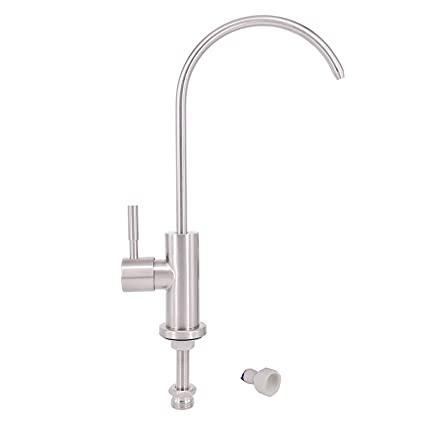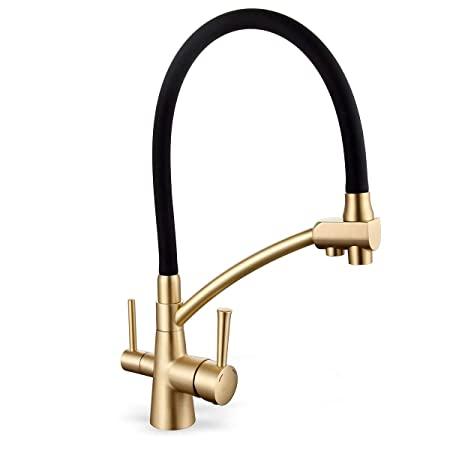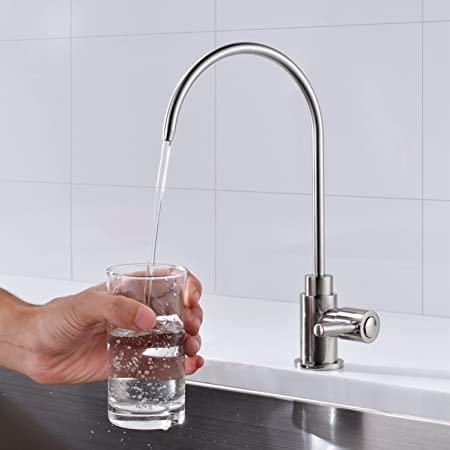It’s no secret that water is essentially the key to life, and is necessary not only for our survival, but also for a number of different processes we utilize on a daily basis. We literally can’t survive without it.
Since water is such a crucial component in our lives, it makes sense to care about the quality and purity of it. One of the easiest ways to get high-quality water is to invest in a few components that work to provide better water than what comes out of our taps — mainly a water filter faucet.
By using a water filter faucet, you can effectively remove tons of different contaminants that may be present in the water. This ensures not only healthier water, but also water with a better taste, and zero chemical odors such as chlorine.
Although there are a number of different methods for providing yourself with purer water, using a water filter for a sink ensures filtration just as the water makes its way out. But is a faucet filter really the best route to take?
The answer to this depends on a number of different factors that range from the actual amount of water you use on a daily basis, to the initial quality of the tap water in your home.
If you’re looking straightforward information about tap water filter methods, you’re in the right place.
Below, we’ll go over all the essentials you need to know about water filtration and purification, and the easiest ways to make the most of your water faucet when it comes to tap water.
In This Article You Will Learn... What is a Water Filter Faucet?How Water Filtration WorksFiltration vs. PurificationWhy You Need to Filter Your WaterThe Problem with Tap WaterWell Water IssuesWhat are the Different Ways to Filter Water?Activated CarbonIon ExchangeReverse OsmosisDistillationOther Water Filtration OptionsWater Pitcher FiltersRefrigerator FiltersIntegrated Faucet FiltersOn-Counter FiltersUnder-Sink FiltersWhole Home FiltersWhat About Bottled Water?What is a Water Filter Faucet?
It’s probably best to first explain the proper definition of a water filter faucet. As the name implies, this category of water filter is one that is basically a part of the water faucet itself, as opposed to an under sink water filter.
By incorporating a filter into the faucet, you can ensure that the tap water is treated before it exits the faucet. This allows the water to be filtered right at the source as it comes out.
In most cases, these filters are simply attached to the end of the faucet head, and replace the head and screen that was there prior to installation. Water filter faucets will also typically have a switch that will allow you to choose either plain tap water, or to route the water through the filter portion.
This lets you pick and choose when to have filtered and non-filtered water, which can come in handy when you are wanting water for drinking in some instances, but merely require tap water for rinsing something or doing the dishes. Either way, you’ll always have the option of selecting filtered water when desired.
Faucet water filters come in several different sizes and designs, but the majority are often small, and can easily be flipped or moved out of the way, so as to leave the regular faucet area unobstructed.
Inside the faucet filter casing, you’ll find the filter cartridge itself. This is the component that actually does all the work, and has a limited lifespan that is determined either in length of time, or by a maximum amount of gallons that can be filtered before the cartridge is no longer effective.

How Water Filtration Works
Water filtration can be done in a number of different ways, and involving several different materials as well.
For the most part, the filtration process involves the water passing through various layers that work to rid it of unwanted particles and chemicals. As the water makes its way through the filter, it’s stripped of chemicals and contaminants that may still remain.
This process can take on several different forms, including using activated carbon, reverse osmosis, ion exchange, and distillation.
Most water filtration processes involve using several different layers or components that treat the water in different ways, most often through the absorption of unwanted components in the water.
For example, activated carbon filters will absorb certain contaminants in the water, while allowing the desirable components of the water to pass through. As the water is passing through the carbon layer, contaminants get trapped within the carbon and remain there, while the purified water continues out of the filter.
Regardless of what technology or method the water filtration device uses, the process always involves the intake of untreated water on one end, and a flow of “clean” water out of the other end.
Filtration vs. Purification
We do need to clarify some things about the two most common terms in regards to filtering water. In some ways it’s a matter of semantics, but technically these terms mean different things — although some may assume they are interchangable.
Water filtration and water purification refer to different processes altogether, even though they do work in conjunction with each other.
Water filtration is actually the more basic of the two, and generally refers to filtering out actual sediment in the water. This can include things like rust, mineral deposits, and possibly even corrosion from miles of water pipes the water usually travels in order to reach your home.
Most every faucet contains some sort of aeration screen within the faucet head itself that helps to catch larger deposits of sediment. While this useful to an extent, the screen only catches larger sediment deposits, which means smaller particles will still make it through.
This is where general water filtration comes in. These filters have smaller screens that will catch smaller particles and prevent them from making it through the faucet’s head. These filters do not purify the water or treat it an any way, they merely catch sediment.
When installed at the water’s point of entry into your house, these filters will catch the sediment before it actually enters your main pipes, and thus prevents any sediment from making it to your sinks and appliances.
This has obvious benefits to drinking water, but it is even better for your appliances. Small sediment particles can cause dishwashers, washing machines, and ice makers in your refrigerator to fail over time, so blocking small sediment pieces is wise decision.
Now for the water purification aspect. Although most water purifiers are still referred to as “filters” (including by the manufacturer themselves,) these products actually do both — filtering sediment from the water, and then treating/purifying the water via other materials and methods.
These water purifiers remove and/or block contaminants in the water, such as lead, chlorine, and limescale. The water is forced through the filter assembly, where it makes its way through various layers that treat certain aspects of the water. By the time it comes out the other end, it’s been thoroughly filtered and purified, resulting in a safer, cleaner, odorless water that is ideal for drinking.
So, anytime you are shopping for a water “filter”, check the information to see if it only blocks sediment, or actually treats and purifies the water as well.

Why You Need to Filter Your Water
If you live anywhere near an urban or suburban area, your home’s water almost always comes from the nearest water treatment plant. At these facilities, water goes through numerous steps and processes that remove various sizes of sediment, chemicals, and more.
Once the water has been deemed as treated and safe, it is then sent into a large network of pipes that deliver the water to your home. On paper, this process should ensure safe and clean water for your home, no matter where you live.
The Problem with Tap Water
Unfortunately, the presence of a water treatment plant does not ensure clean water.
Some of you may recall recent incidents such as the Flint Water Crisis that resulted in an entire town having lead-poisoned water for an extended period of time, resulting in sickness, death, birth defects, and more. While this case is certainly famous, there have been several others like it over the last several decades.
Here’s another thing to keep in mind: Even if your community has never had a disastrous incident or crisis with its water, that doesn’t mean your tap water is perfectly safe or clean. After water is treated at a plant, a small amount of chemicals may still remain when it makes its way to your tap.
Furthermore, the actual pipe system can present a number of issues to your water. Even if the water is perfectly clean when it leaves the treatment plant, the water may still pick up contaminants from the pipes themselves, which may be deteriorating.
There’s also a chance that chemicals and contaminants on the ground above the pipes could make their way into the piping, and bring those chemicals to your tap water. This is an extremely common occurrence that happens more than you may realize.
Even if you water manages to bypass all of these threats, there’s still a chance that your own pipes may have deteriorated and allowed rust and sediment into the water flow.
Well Water Issues
Those who live in rural areas or remote locations may instead have to rely on well water for their home. Although this water may be quite clean in some cases, there’s still a chance it can be contaminated with bacteria from dead animals, chemical runoff from fertilizers and pesticides, and more.
This water can often contain a large amount of sediment, and create massive issues for any appliances that are connected to a water supply.
Water filter faucets can help to instantly filter and purify well water, making it perfectly safe, odorless, and healthier.
So, whether you live in a bustling urban area with modern treatment facilities, or live in a remote area with well water, using a water filter remains essential if you want high-quality water that’s void of any chemicals or contaminants.
What are the Different Ways to Filter Water?
Water filters and systems come in many different mediums, classified by what is used to actually filter and purify the water. These materials and systems all have different ways of treating the water, ranging from complicated to simple.
Activated Carbon
By far the most common water filtering medium, activated carbon is found in nearly every water faucet filter as a part of its filtering process. The carbon inside absorbs organic contaminants such as lead and chlorine, and several others that may contribute to taste and odor issues.
Depending on the filter brand or model, it may also remove solvents, pesticides, and non-organic compounds from the water.
Disadvantages: These filters cannot remove nitrates, bacteria, or dissolved minerals.

Ion Exchange
Ion exchange filters are a newer type that facilitate an atom-swapping process that seems complicated, but is actually quite simple. The filter splits apart atoms of a contaminant in order to make ions, which are then trapped, It then releases the “good” ions that are free of contaminant atoms. Science!
Ion filters can remove the calcium and magnesium that makes water “hard”, and other minerals as well. High-quality models can even remove radium and barium.
Disadvantages: If water has oxidized any iron or iron bacteria, the exchange resin will become clogged and lose its effectiveness. These filters are also often expensive.
Reverse Osmosis
Reverse osmosis involves forcing water to work in the opposite way of normal osmosis, which essentially means forcing it through a very fine filter membrane. This process sounds simple, but it relies on a number of factors to take place.
This process is one of the most effective ways to remove nearly every type of contaminants from water, including nitrates, sodium, other dissolved inorganics and organic compounds, foul tastes, smells, and even colors. It can also reduce the level of most pesticides, dioxins, chloroform, and petrochemicals.
Disadvantages: Usually causes a slow water flow, and is not very compact.
Distillation
Distillation works by creating steam from heating water, trapping contaminants, and then reintegrating that steam back into the separated water. It can remove nitrates, bacteria, sodium, hardness, dissolved solids, most organic compounds, heavy metals, and radionuclides, while killing bacteria.
Disadvantages: Doesn’t work on every contaminant, bacteria may remultiply on cooling coils during long periods of inactivity or use.
Other Water Filtration Options
Aside from water filter faucets, there are several other filtration options you can use, many which can be utilized alongside water filter faucets.
Water Pitcher Filters
Water pitchers with filters typically work the same as a sink-mounted filter, and usually use activated carbon as the main filter medium. These pitchers allow you to create a full pitcher of filtered water that you can store in the refrigerator, or use to serve the water.
With these pitchers, the tap water is often poured into the top portion, where it then makes its way through a filter that acts as the entryway to the bottom portion of the pitcher. The water is filtered by gravity pulling it down through the filter in the middle of the two portions, where it is then deposited into the bottom, where it is ready to be poured.
These pitchers are a great way to pre-filter large servings of water that you can then chill, or leave on your table for family and guests.
Refrigerator Filters
Refrigerator filters are used inside refrigerators that dispense chilled water, either on the outside, or from a spout inside the unit. The filter is installed directly into the refrigerator, where it acts as a filter for both the water spigot, and the icemaker. This ensures clean drinking water and ice at all times.
These filters typically use carbon as the main filter medium, but may integrate other methods as well. They tend to last anywhere from 3 to 6 months, and are somewhat inexpensive.

Integrated Faucet Filters
Integrated faucet filters are similar to conventional faucet filters that mount to the spout, but instead of the filter unit being on the faucet head, it’s built into the faucet itself. The water is routed through the filter before it reaches the faucet head, which saves space and has a better aesthetic appeal as well.
The filter cartridge usually consists of a carbon medium, and is easy to remove and replace as needed. These filters do require the purchase of an entirely new faucet unit that can accomodate a filter, so they may not be an option for some.
On-Counter Filters
On-counter filters consist of a separate filter unit that is not attached to the faucet itself. These instead use a hose or tube connected to the faucet, and then route the water through the filter unit that is placed next to the sink area on the counter.
These filter setups are usually a bit more complicated than the standard carbon filter, and usually involve reverse osmosis systems. They are easy to connect and disconnect to various sinks, but may be an eyesore due to their large profile.
Under-Sink Filters
Under-sink filters are typically larger filter systems that are attached to the pipes that lead to your faucet — under the sink. These filter systems can treat and filter the water before it comes out of the faucet, while remaining out of site and behind the doors under the sink.
Like countertop units, these filters are usually reverse osmosis systems. Under-sink filters are very effective and don’t affect the look of your kitchen area, but are harder to install, and may require a professional.
Whole Home Filters
If you’re serious about filtering your water before it even gets to the piping system in your home, whole home filter systems can provide a simplified way for doing so. These systems are installed right at the source of your water, on the main pipe that leads to the rest of your plumbing. Any water that goes to your sinks and appliances must first run through the filter system.
Whole home filters usually consist of several different filter mediums, and can block small sediment particles as well. They typically require professional installation, and although highly effective, do require a high cost to maintain.
What About Bottled Water?
For many, the easy answer to dealing with contaminants in their water is to simply use bottled water instead. This approach seems logical at first, but presents several problems, both in terms of water quality and in regards to environmental concerns.
First, the water quality aspect. Bottled water is not highly regulated by the EPA, which means there’s a remote chance the water you’re buying may be nearly identical to tap water in terms of contaminants, even if it has a pleasant taste and odor.
Secondly, bottled water is entirely impractical and wasteful. It requires the constant purchase of multiple bottles, and far exceeds the yearly cost of using a water filter faucet, or really any other water filtration method.
Water bottle waste is a big contributor to pollution on a global level, and doesn’t seem to be slowing down. Rather than purchasing cases of bottled water on a regular basis, one should instead consider purchasing a reusable water bottle, and refilling it using a water filtration system at your home.
By doing so, you can ensure that your water is not only properly;y filtered, you’ll also save money, have more convenience, and reduce your carbon footprint.

Final Thoughts
Water filter faucets are a highly convenient and inexpensive way to provide your home or property with a constant flow of fresh, clean, clear, and healthy water void of contaminants and unwanted compounds. They’re easy to install, easy to maintain, and easy to operate.
Are you in the market for a new water filtration system or faucet? Be sure to take a look at our buying guide, where you’ll find our picks for the best faucet water filters, along with some helpful buying advice.
Resources:
mindbodygreenexplainthatstuff